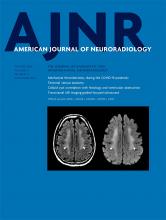Index by author
Goyal, M.
- NeurointerventionYou have accessAntiplatelet Management for Stent-Assisted Coiling and Flow Diversion of Ruptured Intracranial Aneurysms: A DELPHI Consensus StatementJ.M. Ospel, P. Brouwer, F. Dorn, A. Arthur, M.E. Jensen, R. Nogueira, R. Chapot, F. Albuquerque, C. Majoie, M. Jayaraman, A. Taylor, J. Liu, J. Fiehler, N. Sakai, K. Orlov, D. Kallmes, J.F. Fraser, L. Thibault and M. GoyalAmerican Journal of Neuroradiology October 2020, 41 (10) 1856-1862; DOI: https://doi.org/10.3174/ajnr.A6814
Graham, R.M.
- PediatricsOpen AccessMaternal Anxiety and Depression during Late Pregnancy and Newborn Brain White Matter DevelopmentR.M. Graham, L. Jiang, G. McCorkle, B.J. Bellando, S.T. Sorensen, C.M. Glasier, R.H. Ramakrishnaiah, A.C. Rowell, J.L. Coker and X. OuAmerican Journal of Neuroradiology October 2020, 41 (10) 1908-1915; DOI: https://doi.org/10.3174/ajnr.A6759
Graziano, C.
- PediatricsYou have accessIntracranial Arterial Tortuosity in Marfan Syndrome and Loeys-Dietz Syndrome: Tortuosity Index Evaluation Is Useful in the Differential DiagnosisL. Spinardi, G. Vornetti, S. De Martino, R. Golfieri, L. Faccioli, M. Pastore Trossello, C. Graziano, E. Mariucci and A. DontiAmerican Journal of Neuroradiology October 2020, 41 (10) 1916-1922; DOI: https://doi.org/10.3174/ajnr.A6732
Gullapalli, R.
- NeurointerventionYou have accessTranscranial MR Imaging–Guided Focused Ultrasound Interventions Using Deep Learning Synthesized CTP. Su, S. Guo, S. Roys, F. Maier, H. Bhat, E.R. Melhem, D. Gandhi, R. Gullapalli and J. ZhuoAmerican Journal of Neuroradiology October 2020, 41 (10) 1841-1848; DOI: https://doi.org/10.3174/ajnr.A6758
Gumus, E.
- PediatricsOpen AccessMRI Spectrum of Brain Involvement in Sphingosine-1-Phosphate Lyase Insufficiency SyndromeK.W. Martin, N. Weaver, K. Alhasan, E. Gumus, B.R. Sullivan, M. Zenker, F. Hildebrandt and J.D. SabaAmerican Journal of Neuroradiology October 2020, 41 (10) 1943-1948; DOI: https://doi.org/10.3174/ajnr.A6746
Guo, S.
- NeurointerventionYou have accessTranscranial MR Imaging–Guided Focused Ultrasound Interventions Using Deep Learning Synthesized CTP. Su, S. Guo, S. Roys, F. Maier, H. Bhat, E.R. Melhem, D. Gandhi, R. Gullapalli and J. ZhuoAmerican Journal of Neuroradiology October 2020, 41 (10) 1841-1848; DOI: https://doi.org/10.3174/ajnr.A6758
Hamzei-sichani, F.
- Adult BrainOpen AccessBilateral Basal Ganglia Hemorrhage in a Patient with Confirmed COVID-19R. Daci, M. Kennelly, A. Ferris, M.U. Azeem, M.D. Johnson, F. Hamzei-Sichani, A.H. Jun-O’Connell and S.K. NatarajanAmerican Journal of Neuroradiology October 2020, 41 (10) 1797-1799; DOI: https://doi.org/10.3174/ajnr.A6712
Hasan, D.M.
- NeurointerventionYou have accessQuantifying Intra-Arterial Verapamil Response as a Diagnostic Tool for Reversible Cerebral Vasoconstriction SyndromeJ.M. Sequeiros, J.A. Roa, R.P. Sabotin, S. Dandapat, S. Ortega-Gutierrez, E.C. Leira, C.P. Derdeyn, G. Bathla, D.M. Hasan and E.A. SamaniegoAmerican Journal of Neuroradiology October 2020, 41 (10) 1869-1875; DOI: https://doi.org/10.3174/ajnr.A6772
Heier, L.A.
- FELLOWS' JOURNAL CLUBHead & NeckOpen AccessOlfactory Bulb Signal Abnormality in Patients with COVID-19 Who Present with Neurologic SymptomsS.B. Strauss, J.E. Lantos, L.A. Heier, D.R. Shatzkes and C.D. PhillipsAmerican Journal of Neuroradiology October 2020, 41 (10) 1882-1887; DOI: https://doi.org/10.3174/ajnr.A6751
This retrospective case-control study compared the olfactory bulb and olfactory tract signal intensity on thin-section T2WI and postcontrast 3D T2 FLAIR images in patients with COVID-19 and neurologic symptoms, and age-matched controls imaged for olfactory dysfunction. Olfactory bulb 3D T2-FLAIR signal intensity was greater in the patients with COVID-19 and neurologic symptoms compared with an age-matched control group with olfactory dysfunction, and this was qualitatively apparent in 4 of 12 patients with COVID-19. Analysis of these preliminary findings suggests that olfactory apparatus vulnerability to COVID-19 might be supported on conventional neuroimaging and may serve as a noninvasive biomarker of infection.
Heiss, J.D.
- EDITOR'S CHOICEAdult BrainOpen AccessTentorial Venous Anatomy: Variation in the Healthy PopulationJ.S. Rosenblum, J.M. Tunacao, V. Chandrashekhar, A. Jha, M. Neto, C. Weiss, J. Smirniotopoulos, B.R. Rosenblum and J.D. HeissAmerican Journal of Neuroradiology October 2020, 41 (10) 1825-1832; DOI: https://doi.org/10.3174/ajnr.A6775
The authors retrospectively reviewed tentorial venous anatomy of the head using CTA/CTV performed for routine care or research purposes in 238 patients. Tentorial vein development was related to the ring configuration of the tentorial sinuses. There were 3 configurations: Groups 1A and 1B had ring configuration, while group 2 did not. Group 1A had a medialized ring configuration, and group 1B had a lateralized ring configuration. Measurements of skull base development were predictive of these groups. The ring configuration of group 1 was related to the presence of a split confluens, which correlated with a decreased internal auditory canal-petroclival fissure angle. Configuration 1A was related to the degree of petrous apex pneumatization.








